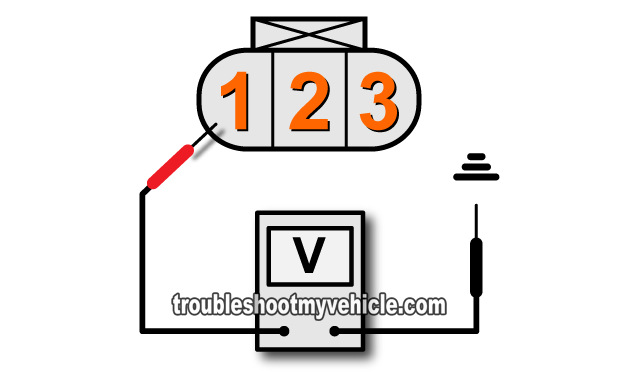TEST 2: Making Sure The TPS Is Getting Power

The throttle position sensor (TPS) on your 2.0L Chrysler gets power, in the form of 5 Volts DC, on the violet with white stripe (VIO/WHT) wire of the TP sensor's harness wire.
We can confirm that this voltage is being supplied to the TPS with a simple multimeter voltage test, and that's what we'll do in this test section.
NOTE: Avoid probing the TP sensor harness connector's front metal terminals. Instead, you should back-probe the connector with the appropriate tool or use a wire-piercing probe.
With the multimeter in Volts DC mode, this is what you need to do:
- 1
Connect the red multimeter test lead to the VIO/WHT wire of the TPS harness connector
This is the wire that connects to the terminal labeled with the number 1. - 2
Ground the black multimeter test lead directly on the battery negative (-) terminal.
- 3
Have a helper turn the key to the On position, but don't crank or start the engine after the multimeter test leads have been set up.
- 4
Your multimeter should register 4.5 to 5 Volts DC if the VIO/WHT wire is feeding the throttle position sensor (TPS) with power.
Let's take a look at what your test results mean:
CASE 1: The multimeter registered 4.5 to 5 Volts DC. This is the correct and expected test result.
Your next step is to make sure that the TPS is getting Ground on the black with light blue stripe (BLK/LT BLU) wire. For this test, go to: TEST 3: Making Sure The TPS Is Getting Ground.
CASE 2: The multimeter DID NOT register 4.5 to 5 Volts DC. Re-check your multimeter test lead connections and re-test. If the multimeter still does not show the indicated voltage, then you've found the reason why the TPS did not create a voltage signal in TEST 1.
Although it's beyond the scope of this tutorial to find the reason why these 5 Volts are missing, you'll need to get yourself a wiring diagram (for your particular mini-van) and check the continuity of this wire between the TPS and the PCM.
TEST 3: Making Sure The TPS Is Getting Ground

So far, you have checked and confirmed that:
One: That the TP sensor is not creating an increasing/decreasing throttle plate voltage signal on the ORG/DK BLU wire (TEST 1).
Two: That the TP sensor is getting power on the VIO/WHT wire of the TPS harness connector (TEST 2).
The last test is to make sure that the BLK/LT BLU wire is feeding the TPS with Ground.
NOTE: Be careful and do not short this wire to battery voltage, or you'll fry your Chrysler's PCM.
These are the test steps:
- 1
Connect the black multimeter test lead to the BLK/LT BLU wire of the TPS harness connector
This is the wire that connects to the terminal labeled with the number 3. - 2
Connect the red multimeter test lead directly on the battery's positive (+) terminal.
- 3
Have a helper turn the key to the On position, but don't crank or start the engine after the multimeter test leads have been set up.
- 4
Your multimeter should register 12 Volts DC if the BLK/LT BLU wire is feeding the throttle position sensor (TPS) with Ground.
Let's take a look at what your multimeter test results mean:
CASE 1: The multimeter registered 12 Volts DC. This test result confirms that the TPS is getting Ground. Now, since you have:
- Confirmed that the TPS is not creating a throttle plate angle voltage signal (TEST 1).
- Confirmed that it is getting power (TEST 2).
And in this test step you have confirmed that the throttle position sensor is getting Ground, then you can conclude that the reason its not creating a throttle plate angle signal is because it is defective and needs to be replaced.
CASE 2: The multimeter DID NOT register 12 Volts DC. Re-check your multimeter test lead connections and re-test. If the multimeter still does not show the indicated voltage, then you've found the reason why the TPS did not create a voltage signal in TEST 1.
Although it's beyond the scope of this tutorial to find the reason why this Ground is missing, you'll need to get yourself a wiring diagram (for your particular Chrysler) and check the continuity of this wire between the TPS and the PCM.
More 2.0L Chrysler Tutorials
You can find a complete list of tutorials in this index: Chrysler 2.0L, 2.4L Index Of Articles.
- How To Test The Fuel Pump (Chrysler 2.0L, 2.4L).
- How To Troubleshoot A No Start (Chrysler 2.0L, 2.4L).
- How To Test The Engine Compression (Chrysler 2.0L, 2.4L).
- How To Test Misfire Codes (Chrysler 2.0L, 2.4L).
- How To Test A Fuel Injector (Chrysler 2.0L, 2.4L).
- How To Test The Coil Pack (Chrysler 2.0L, 2.4L) (at: easyautodiagnostics.com).

If this info saved the day, buy me a beer!

